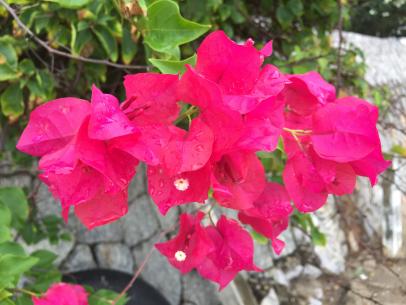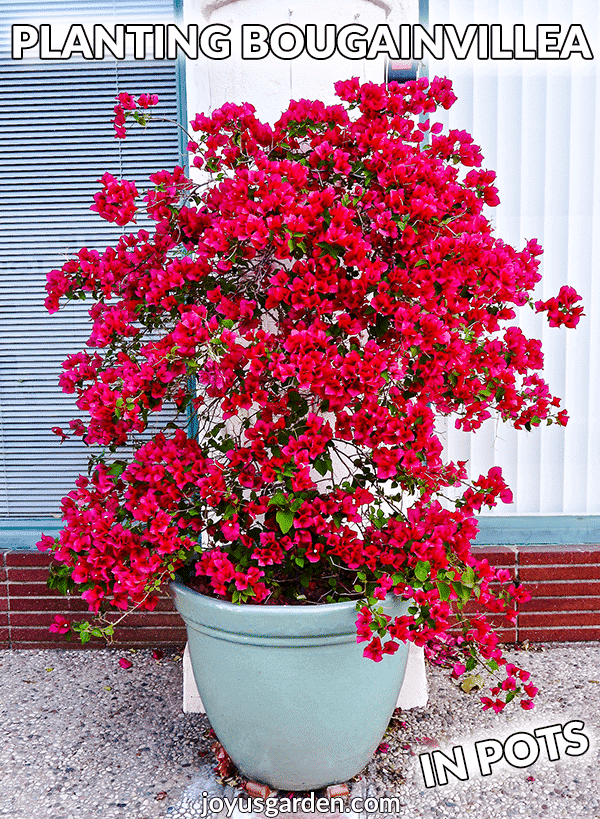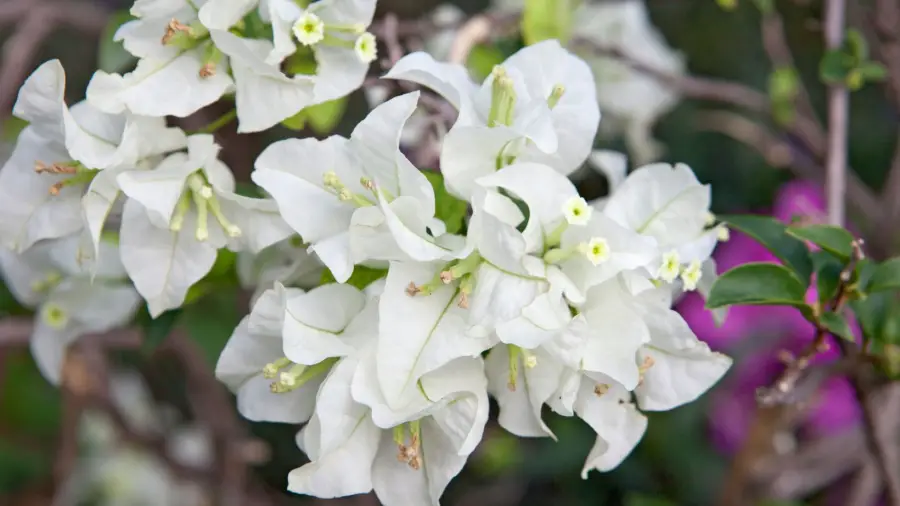Bougainvillea thrives in well-drained, slightly acidic soil with good drainage. Use a potting mix rich in organic matter suited for cacti or palms.
Bougainvillea is a vibrant, hardy plant that dazzles with its colorful floral displays and lush growth. Known for its drought tolerance and preference for sunny locations, providing the right soil conditions is crucial for the plant’s success. Gardeners often opt for a loamy or sandy soil blend, ensuring it’s not too heavy or moisture-retentive, as the roots are prone to rot if waterlogged.
Table of Contents
By creating an environment that mimics its native habitat, you can enjoy the full splendor of bougainvillea in your garden or patio. It’s essential to select a planting medium that allows for quick water passage while still retaining the necessary nutrients to fuel this plant’s vigorous growth.

Credit:http://www.hgtv.com
Introduction To Bougainvillea: Understanding The Basics
An explosion of color that cascades in a vibrant spectacle, bougainvillea plants bring life and beauty to any garden space. Understanding the basics of these lush, tropical climbers is essential for both novice and expert gardeners looking to revel in their grand display. Let’s delve into the world of bougainvilleas—starting with their captivating nature and what they fundamentally require to flourish.
The Nature And Beauty Of Bougainvillea
Bougainvillea plants are known for their striking flower-like spring leaves around tiny, white flowers. These hardy climbers can often be found sprawling over walls and fences, or adding colorful accents to garden trellises. They come in a variety of hues, including pink, purple, orange, yellow, and white, which can transform any landscape into a tropical paradise.
The Essential Requirements For Optimal Growth
To achieve the best display of lush foliage and vibrant blooms, bougainvillea requires certain conditions:
- Well-draining soil: Prevents root rot and is fundamental for overall plant health.
- Sufficient sunlight: Bougainvilleas thrive with at least 5-6 hours of full sun daily.
- Mild temperatures: These plants prefer the warmth, ideally between 60-100°F (15-37°C).
- Controlled watering: Overwatering can harm the plants, so it’s important to let the soil dry out between sessions.
- Specific soil pH: A slightly acidic to neutral soil pH, from 5.5 to 7.0, is optimal.
The Ideal Soil Composition For Bougainvillea
Thriving in warm climates, bougainvillea plants adorn many gardens with their vibrant colors and lush growth. Essential to their success is the soil in which they’re planted. The optimal composition of bougainvillea soil ensures these hearty climbers receive adequate nutrients and water drainage, preventing common issues such as root rot while promoting vigorous flowering.
Characteristics Of The Perfect Bougainvillea Soil Mix
A well-draining and aerated soil that mimics their native environment is key for bougainvillea. Here are the essential characteristics:
- Texture: Coarse and loosely packed for air passage
- Composition: A mix of peat, pine bark, and coarse sand or perlite
- Drainage: Excellent to prevent waterlogging
- Nutrient content: Rich in essential nutrients but not overly fertile, as too much nitrogen can impede flowering
The Role Of Drainage In Preventing Root Rot
Bougainvillea’s roots are sensitive to excess moisture. Poor drainage can lead to root rot, a condition that can severely damage or kill the plant. A soil mix with good drainage allows water to pass through quickly, preventing the roots from sitting in dampness. Consider incorporating materials like perlite or gravel to enhance soil porosity and ensure optimal water flow.
Adjusting Soil Ph For Bougainvillea Health
Bougainvillea prefers a slightly acidic pH between 5.5 and 6.5. Soil that is too alkaline can hinder nutrient absorption, causing deficiencies and inhibiting growth. Test the soil pH regularly and, if necessary, amend it using soil acidifiers or organic mulches like pine needles to maintain the ideal range.
Organic Vs. Inorganic Components: Striking The Right Balance
Finding the right mix of organic and inorganic elements in the soil is crucial for bougainvillea. Organic materials like compost or peat moss contribute to the soil’s nutrient content and water retention. In contrast, inorganic additives like vermiculite or perlite improve drainage and aeration. Balance these components to create an environment that supports healthy root growth and vibrant blooms.
Best Practices For Planting And Maintaining Bougainvillea
To ensure your Bougainvillea flourishes, understanding the optimum soil composition and care practices is essential. The right soil and maintenance routine can make the difference between a vibrant display of color and a lackluster plant.
Preparation And Planting Techniques In Pots
Getting Bougainvillea off to a strong start begins with proper planting techniques. For pots:
- Select a container with ample drainage holes to prevent waterlogging.
- Choose a high-quality potting mix that ensures good aeration and drainage.
- Plant at the same depth the bougainvillea was growing in its nursery pot to avoid root suffocation.
- Make sure to position the pot in a location where the plant will receive full sun for most of the day.
Incorporating The Right Soil Amendments
Soil amendments play a crucial role in the health of your Bougainvillea. These include:
- Perlite or sand to improve drainage.
- Organic compost to provide essential nutrients.
- Soil acidifiers such as sulfur if your native soil is too alkaline.
Amend the potting mix thoroughly before planting to create the ideal environment for root growth.
Frequency And Depth Of Watering For Optimal Growth
For bougainvilleas, watering correctly is pivotal for optimal growth:
- Water when the top inch of soil feels dry.
- Avoid overwatering, which can lead to root rot.
- Ensure deep water penetration to encourage a robust root system.
Adjust the frequency based on the season; less in winter when the plant is not actively growing, and more in the hot summer months.
Repotting Tips: When And How To Do It Effectively
Repotting your Bougainvillea provides fresh nutrients and room to grow. Follow these tips:
- Choose the right time: Early spring is ideal, before a new growth spurt.
- Upgrade to a pot that’s one size larger to prevent shock.
- Handle roots with care to avoid damage, as this can affect the plant’s health.
- After repotting, water thoroughly to settle the soil around the roots.
With attention to these practices, your bougainvillea will continue to thrive and impress with its bountiful blooms.
Additional Tips For Thriving Bougainvillea
Bougainvillea dazzle with their vibrant colors and lush growth, making them a stunning addition to any garden. For these tropical beauties to truly flourish, the right conditions are essential—beyond just choosing the best soil. Here are some additional tips to ensure your bougainvillea thrives.
Choosing The Right Pot And Trellis For Support
Selecting the correct pot and trellis will provide the support your bougainvillea needs to grow robust and healthy. A well-drained pot is critical to prevent root rot and other water-related issues. Look for pots with multiple drainage holes and consider using terra cotta or similar breathable materials.
- Size of the pot: Large enough to accommodate growth but not so big that the roots stay soggy.
- Material of the trellis: Durable materials like wood or metal that can withstand the weight of a mature plant.
Employ a trellis that compliments the size of your plant and allows for suitable training of the vines, ensuring sunlight exposure is maximized for all parts of the plant.
Fertilization Strategies For Vibrant Blooms
Bougainvilleas are heavy feeders and require consistent fertilization to produce their signature blooms. Use a high-phosphorus fertilizer to encourage blooming and vibrant colors. Balanced feeding throughout the growing season supports robust foliage and flowering.
- Apply a slow-release fertilizer during the planting stage and at the beginning of the growing season.
- During peak blooming periods, switch to a water-soluble fertilizer, applied bi-weekly.
Maintain a regular fertilization schedule but be careful not to over-fertilize, as this can be detrimental to plant health.
Common Mistakes To Avoid With Bougainvillea Care
Ensure the longevity and beauty of your bougainvillea by steering clear of these common care mistakes:
- Overwatering: Bougainvillea prefer dry soil; allow the top layer to dry out before watering again.
- Excessive pruning: Only prune after a bloom cycle has completed to avoid cutting off new buds.
- Neglecting light requirements: These plants need full sun to thrive; insufficient light can limit blooming.
Troubleshooting: Addressing Common Soil And Plant Health Issues
Sometimes, despite our best efforts, issues may arise. Here’s how to troubleshoot some common problems:
| Issue | Possible Cause | Solution |
|---|---|---|
| Lack of Blooms | Poor soil fertility or inadequate sunlight | Improve nutrient levels with a suitable fertilizer and ensure full sun exposure |
| Yellowing Leaves | Waterlogging or over-fertilization | Adjust watering habits and review fertilizer application rates |
| Fungal Diseases | High humidity or excess moisture | Improve air circulation and reduce watering frequency |
Monitor your bougainvillea’s health regularly and adjust your care practices as necessary to maintain the optimal balance of moisture, nutrition, and sunlight.
Region-specific Advice For Bougainvillea Cultivation
When it comes to cultivating bougainvillea, one size does not fit all—especially with regard to soil composition. The beauty and health of this vibrant plant can vary dramatically based on the local environment. In the following sections, we’ll delve into how to adapt your soil mix to different climate conditions, the wisdom gleaned from expert gardeners and educational institutions, and inspiring case studies of bougainvillea that thrived across diverse regions.
Adapting The Soil Mix To Local Climate Conditions
Bougainvillea prospers in well-drained soil that can support its vibrant growth. Local climate conditions, such as humidity, rainfall, and temperature, play a crucial role in determining the ideal soil mix for your bougainvillea. Here are some tailored tips for different climates:
- Arid Regions: Mix in sand or perlite to enhance drainage and mimic the plant’s natural habitat.
- Humid Regions: Incorporate coarse materials like pine bark to prevent waterlogging.
- Cooler Climates: Warmer soils promote growth; consider a darker-colored mulch to increase soil temperature.
Expert Advice From Gardening Communities And Universities
Reaching out to local gardening communities and nearby universities can provide invaluable insights into what works best for bougainvillea in your area. Many universities with agricultural departments offer free advisories and soil testing that can help you understand what your bougainvillea might need:
| Resource | Type of Advice | Contact |
|---|---|---|
| Local Gardening Clubs | Personalized tips, plant swaps | Check community boards |
| Agricultural Extensions | Soil testing, tailored recommendations | Visit university websites |
Case Studies: Successful Bougainvillea Growth In Various Regions
Learn from the successes of other bougainvillea gardeners across a spectrum of climates. Case studies illustrate how gardeners have overcome regional challenges to cultivate thriving plants. Below are some success stories:
- Desert Oasis: Discover how one Arizona gardener incorporated local cacti mix to create the perfect desert bougainvillea paradise.
- Coastal Flourish: Read about the California coast’s specific challenges and how gardeners there use custom soil enhancements to foster growth.
- Tropical Beauty: Explore how Floridians deal with humidity and frequent rains when growing bougainvillea in a subtropical climate.

Credit: http://www.joyusgarden.com

Credit: http://www.searlesgardening.com.au
Frequently Asked Questions Of Best Soil For Bougainvillea
What Soil Do I Need For A Bougainvillea?
Bougainvilleas flourish in well-drained, slightly acidic to neutral soil with good aeration. Use a potting mix designed for cactus or palms for optimal growth.
What Is The Potting Mix For Bougainvillea?
The best potting mix for bougainvillea is well-draining and slightly acidic. Use a mix designed for cacti or palms with minimal peat moss to prevent root rot.
What Type Of Trellis Is Best For Bougainvillea?
A sturdy wall trellis is the best option for supporting a bougainvillea’s growth.
How Do You Repot Bougainvillea?
Choose a well-draining soil mix, preferably for cactus or palms. Select a new pot slightly larger than the current one with drainage holes. Carefully remove the bougainvillea, avoiding root damage. Place it in the new pot and fill with soil, then water lightly.
Conclusion
Choosing the right soil is crucial for vibrant bougainvillea blooms. Remember, well-draining, slightly acidic soil ensures healthy growth. A loamy mix with sand, perlite, or compost works wonders. Regular checks for soil moisture balance support thriving plants. Let these tips guide your gardening passion, ensuring your bougainvillea remains a stunning showpiece.
Keep nurturing, and enjoy the colorful cascade of blooms that follow!
(To know more about Bougainvillea Care: https://bonsainurserybd.com/bougainvillea-plant-how-to-care-for-your-bougainvillea-plant-tips-and-tricks/)
